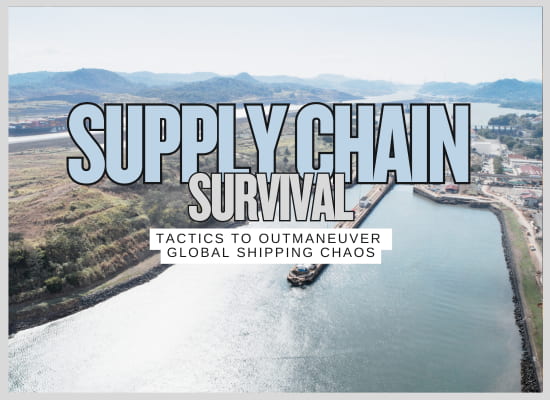Top Strategies to Protect Your Maritime Business from Supply Chain Disruptions

In 2025, maritime supply chains are navigating more turbulence than ever—Red Sea conflict reroutes, fuel price volatility, regulatory overhauls, tariffs, and cyber risks are just the tip of the iceberg. If you're not actively fortifying your logistics strategy, you're gambling with delays, rising costs, and lost clients.
Whether you operate a fleet, manage port logistics, or supply goods to ships at sea, supply chain disruptions are no longer occasional—they’re structural.

We welcome your feedback, suggestions, corrections, and ideas for enhancements. Please click here to get in touch.
Here’s what you’re up against:
- Geopolitical flashpoints forcing global rerouting
- IMO carbon fees reshaping fuel and emissions planning
- Ongoing trade wars and retaliatory tariffs disrupting cargo flows and sourcing
- Port congestion and labor shortages impacting vessel turnaround
- Limited supplier diversification for mission-critical components
- Increased cyber threats targeting fleet and freight infrastructure
These are not short-term issues—they require strategic, long-term responses.
In our latest report we walk through 15 field-tested strategies that leading maritime businesses are using to stay agile and resilient.
Global chokepoints like the Suez Canal, Panama Canal, and Strait of Hormuz handle a massive share of maritime trade—but they also present critical vulnerabilities. Political instability, environmental restrictions, and conflict in these areas can lead to costly delays and emergency rerouting. Building route flexibility into your logistics planning is essential for long-term resilience.
🚨 Recognize Where You're Exposed:- Red Sea attacks in 2024–2025 forced reroutes around Africa, driving fuel and insurance costs sharply higher.
- Panama Canal restrictions due to drought conditions cut daily transits by more than 35%.
- Heavily-used lanes become pressure points when crisis strikes.
- Map alternative paths for key shipping corridors in advance.
- Use dynamic AIS data and weather routing to adjust mid-transit.
- Negotiate flexible charter agreements that allow rerouting without penalties.
- Develop port relationships in backup corridors (e.g., East Africa, South America).
- Partner with freight forwarders who specialize in alternate lanes.
- Include secondary route readiness in your annual risk assessments.
Relying on a single supplier—or even a single region—for essential equipment, parts, or provisions leaves your maritime operation exposed. From customs delays to export bans or labor strikes, localized issues can ripple across your entire fleet. By sourcing from multiple geographic zones, you can better absorb shocks and avoid full stoppages.
🛑 Avoid Single Point Failures:- Delays from one supplier can halt operations across multiple vessels.
- Regulatory shifts or tariffs in one country can make sourcing there unfeasible overnight.
- Natural disasters or port closures can eliminate access to entire markets temporarily.
- Identify alternative suppliers in at least two additional countries for critical categories.
- Prioritize suppliers in regions with different climate, political, and trade risk profiles.
- Maintain small standby orders with backups to ensure readiness without overstocking.
- Negotiate supply agreements with volume flexibility and variable fulfillment locations.
- Establish mutual emergency support clauses with regional vendors.
- Use performance tracking tools to evaluate and rotate suppliers based on reliability.
In a world of volatile shipping conditions, real-time visibility is no longer a luxury—it’s a baseline requirement. Without accurate, real-time data on vessel position and cargo status, operators are left guessing when issues arise. Integrated tracking systems provide the intelligence needed to reroute early, communicate with stakeholders, and minimize downstream disruption.
📉 Eliminate Blind Spots in Your Supply Chain:- Static ETAs create false confidence and delay corrective actions.
- Untracked cargo leaves charterers and customers in the dark.
- Manual check-ins can’t keep up with fast-moving disruptions.
- Implement AIS-based systems to monitor vessel position globally.
- Use RFID, IoT sensors, and satellite trackers for container-level insights.
- Integrate tracking into TMS or ERP platforms for end-to-end visibility.
- Trigger alerts when routes deviate or ports become congested.
- Share live updates with shippers, receivers, and chartering agents.
- Use predictive ETA tools to dynamically adjust schedules and crew planning.
Predictive analytics helps you move from reactive firefighting to proactive decision-making. By analyzing patterns in historical data, weather, port congestion, vessel behavior, and global events, modern tools can forecast disruptions before they happen—giving you time to adapt your strategy.
⏱️ Stop Reacting and Start Anticipating:- Traditional tracking only shows what's already happened.
- Delays often cascade through interconnected routes and suppliers.
- Missing early indicators reduces time to respond effectively.
- Use platforms that analyze vessel traffic, port turnaround times, and weather trends.
- Integrate real-time global risk alerts into your planning systems.
- Leverage AI models that predict disruptions based on traffic density and trade flow shifts.
- Give operators and planners visibility into forward-looking risk models.
- Automate alerts for at-risk cargoes or shipping lanes.
- Use delay forecasts to prioritize rerouting or alternate sourcing actions early.
Port congestion is a growing threat to maritime scheduling—and once your vessel is stuck at anchorage, options are limited. By securing priority berthing agreements with key ports, operators can reduce wait times, improve schedule reliability, and better control downstream logistics.
⚠️ Don’t Leave Port Access to Chance:- High-traffic ports often operate on first-come, first-served or capacity-based models.
- Surges in traffic due to rerouting, labor shortages, or weather can leave vessels waiting days.
- Unplanned delays at port throw off charter schedules, delivery windows, and crew rotations.
- Negotiate advance berthing windows during contract discussions.
- Secure conditional access for time-sensitive cargo or high-frequency routes.
- Consider seasonal agreements during high-risk congestion periods.
- Collaborate with port authorities on slot management and vessel coordination.
- Provide digital pre-arrival documentation to reduce processing time.
- Maintain regular communication with port agents to anticipate bottlenecks early.
When disruptions hit sea routes, the ability to shift cargo through rail, truck, or air can be a game-changer. Multi-modal logistics isn’t just about efficiency—it’s about resilience. Integrating flexible transport alternatives ensures continuity when ports are congested, lanes are blocked, or vessels are delayed.
🚫 Don’t Get Boxed Into a Single Mode:- Exclusive reliance on ocean freight exposes you to full-system stoppages.
- Trucking shortages and rail strikes can magnify delays without backup options.
- Lack of modal alternatives limits rerouting capabilities during crises.
- Identify inland depots and intermodal hubs near key destinations.
- Partner with 3PLs that offer blended shipping contracts across modes.
- Pre-clear documentation requirements for air or rail transfers in high-risk zones.
- Use TMS platforms that support dynamic mode-switching based on disruption triggers.
- Train logistics teams on managing transitions between freight modes.
- Balance speed and cost tradeoffs for critical vs. non-urgent shipments.
Buffer warehousing near high-demand regions provides a cushion against delays, allowing maritime businesses to continue fulfilling contracts even if ships are late or routes shift. With port congestion, customs slowdowns, and regional instability becoming more common, forward-staging inventory reduces last-mile pressure and increases operational resilience.
📦 Avoid Last-Minute Scrambles:- Just-in-time models fail when vessel arrivals are unpredictable.
- Delays at sea can cascade into downstream shortages and penalties.
- Clients expect reliability—buffer inventory protects your reputation.
- Target locations near major ports, distribution centers, or manufacturing clusters.
- Use bonded warehousing when duties and customs clearance delays are a factor.
- Adjust inventory levels based on seasonal trends and transit volatility.
- Integrate demand forecasts and transit data into warehouse replenishment planning.
- Set dynamic reorder points based on route risk and inventory movement.
- Use WMS tools that link directly with vessel ETAs and customs updates.
As global instability rises, standard maritime insurance policies may leave critical exposures uncovered. From vessel rerouting due to conflict to cargo damage from extreme weather, the financial fallout of uncovered events can be severe. Reviewing and updating your policies to account for today's risk environment is essential.
🌪️ Don’t Assume You're Fully Covered:- Many base policies exclude war zones, piracy, and sanctions-related disruptions.
- Climate-driven events—like hurricanes and flooding—may not trigger payouts without specific riders.
- Delays due to port closures or reroutes often fall into policy gray areas.
- Review exclusions related to war, political unrest, and natural disasters.
- Check cargo policies for clauses around spoilage or extended delays.
- Ensure business interruption coverage includes maritime-specific triggers.
- Consider adding war risk, strike & detention, and parametric climate coverage riders.
- Work with brokers who understand emerging maritime threats and markets.
- Update declared routes and cargo values frequently to avoid denial of claims.
Maritime risk zones are constantly shifting—conflict, piracy, sanctions, and environmental conditions can all transform a safe lane into a high-risk corridor overnight. Ongoing monitoring allows operators to make fast, informed routing decisions and alert vessels, cargo owners, and clients before a disruption becomes a crisis.
⚠️ Don’t Rely on Static Risk Maps:- Conflict zones like the Red Sea evolved rapidly in 2024–2025, catching many operators off-guard.
- New sanctions, embargoes, or blockades can change permissible routes in real time.
- Seasonal piracy surges (e.g., Gulf of Guinea) demand dynamic awareness.
- Subscribe to alerts from maritime security firms and naval agencies.
- Use AIS and satellite tracking tools to flag abnormal vessel behavior or port disruptions.
- Monitor weather and natural disaster forecasts affecting coastal and strait regions.
- Feed live threat data into route planning and dispatch tools.
- Designate a team or point person responsible for watching global security updates.
- Issue automatic advisories to crew and clients if routes cross into high-risk areas.
As vessels become more connected, they also become more vulnerable. From ECDIS navigation systems to satellite comms and cargo tracking platforms, cyberattacks can disable operations, steal data, or even compromise vessel control. A proactive cybersecurity framework is no longer optional—it's mission-critical.
🧨 Understand Your Vulnerabilities:- Outdated bridge systems may lack basic access controls or encryption.
- Phishing remains the most common method used to breach onboard systems.
- Remote access tools can become a threat vector if not properly secured.
- Apply regular software updates and security patches to all shipboard systems.
- Use firewalls, intrusion detection systems, and access logs on all networks.
- Segment networks to separate critical navigation systems from crew internet access.
- Conduct regular cybersecurity drills and phishing simulations.
- Establish clear response protocols for cyber incidents.
- Ensure every crew member knows the basics of digital hygiene and reporting.
Maritime regulations are evolving rapidly, especially around emissions and sustainability. From IMO carbon intensity rules to global greenhouse gas levies, these changes can directly impact routing, fuel strategy, vessel eligibility, and total operating costs. Businesses that plan ahead can adapt smoothly—those that don’t risk costly compliance failures.
📋 Stay Ahead of Shifting Rules:- IMO’s GHG fee framework will take effect starting in 2027, with per-ton emissions charges.
- Carbon intensity ratings (CII) and energy efficiency indexes (EEXI) are now mandatory for most vessels.
- New fuel standards may limit or ban high-sulfur fuel in key regions.
- Non-compliant vessels may face route restrictions or port access limitations.
- Falling behind on reporting standards can result in penalties or denied entry.
- Low-rated ships may see reduced charter opportunities or reputational risk.
- Track regulatory timelines from IMO, EU ETS, and regional authorities.
- Start evaluating low-emission fuels, retrofit options, and carbon accounting tools now.
- Work with technical advisors to model carbon costs under various scenarios.
Even the best contingency plans fall short without trained people to execute them. Crews and shore teams must be equipped to handle rerouting, system outages, port closures, and emergency communications. When disruption strikes, clear roles and practiced coordination reduce delays, minimize losses, and protect safety.
🚧 Identify Common Weak Spots:- Unfamiliarity with rerouting protocols or alternative port access procedures.
- Poor communication between ship and shore during high-pressure events.
- Delays due to confusion over who’s responsible for key decisions.
- Run scenario-based drills for common disruption types (e.g., cyberattack, piracy alert, port closure).
- Ensure both onboard and logistics staff know how to access and update contingency plans.
- Train backup personnel for critical roles to cover gaps during emergencies.
- Use secure, reliable channels with redundancy in case of signal loss.
- Establish clear reporting structures and escalation paths.
- Conduct post-incident reviews and use insights to improve procedures.
Third-party logistics providers (3PLs) with maritime specialization offer critical support when routes collapse, ports shut down, or regulations shift. The right 3PL brings global reach, multi-modal expertise, and on-the-ground resources that allow your business to pivot fast—without building that capacity internally.
🌐 Don’t Go It Alone in Global Disruptions:- In-house teams may lack resources to respond to sudden rerouting needs or customs backlogs.
- Local agents often don’t have visibility or leverage beyond their port region.
- Global disruptions require global coordination.
- Look for providers experienced in vessel scheduling, NVOCC coordination, and port agency services.
- Evaluate their past performance during disruptions—speed of response, rerouting capability, and customs resolution.
- Confirm they offer real-time tracking integrations and reporting tools tailored to shipping operations.
- Collaborate on disruption playbooks and contingency plans.
- Share forecasts and demand patterns to help them prioritize your cargo in tight situations.
- Review and renew partnerships annually based on reliability, flexibility, and value-added services.
Paper-based shipping documents are slow, error-prone, and vulnerable to loss or delays—especially during port congestion, customs inspections, or geopolitical events. Digitizing bills of lading, manifests, and compliance forms speeds up processing, reduces human error, and allows for smoother transitions across borders and modes.
📄 Recognize the Hidden Cost of Paper:- Manual paperwork can delay cargo clearance by hours or even days.
- Lost or misfiled documents cause billing errors, fines, and rework.
- Paper is easily damaged, hard to search, and lacks real-time traceability.
- Adopt eBOL (electronic bill of lading) systems compatible with port and carrier platforms.
- Use automation tools to generate, transmit, and archive key documents securely.
- Digitally integrate certificates of origin, HS codes, customs declarations, and cargo inspections.
- Reduce clearance times and avoid document-related demurrage charges.
- Ensure consistent document formatting for faster partner and authority processing.
- Link documentation to shipment tracking for better visibility across your supply chain.
No single operator has visibility into all the risks affecting maritime trade. By joining collaborative maritime networks—both formal and informal—your business can gain real-time access to intelligence on port delays, route hazards, regulatory changes, and security alerts. Shared knowledge shortens response times and helps the entire industry stay agile.
🛰️ Don't Operate in Isolation:- Solo operators may miss early warning signs of disruptions others have already flagged.
- Lack of shared insights leads to redundant mistakes across fleets and firms.
- Disconnected actors can't coordinate responses to port or customs challenges.
- Join regional port user groups, industry roundtables, or maritime associations.
- Subscribe to shared threat-alert platforms and real-time shipping community channels.
- Engage with classification societies, flag state advisories, and trade analytics groups.
- Share disruption data and incident reports to strengthen collective awareness.
- Participate in joint contingency planning with key partners and competitors.
- Use shared intelligence to pressure-test your own planning and improve industry resilience.
📝 Table Summary

Do you have a Maritime Product or Service that may be of interest to Shipowners? Tell us about it here!
Do you have feedback or insights? Please reach out to editor @ shipuniverse.com



